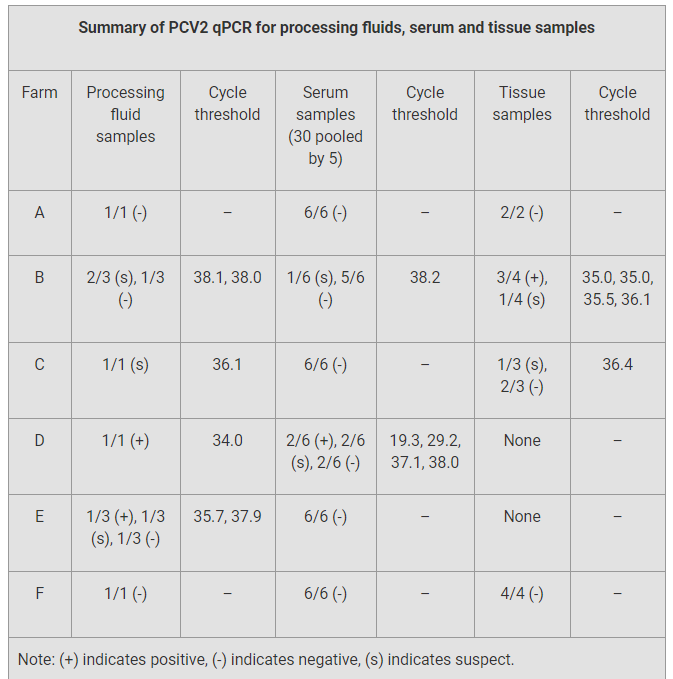



Processing fluids provide an option to monitor PCV2 and PCVAD
Porcine circovirus type 2 (PCV2) is found among pig herds throughout the world and contributes to the disease syndrome known as porcine circovirus associated disease (PCVAD). Upping the challenge to addressing this ubiquitous virus is the fact that it is resilient to many common disinfectants, which allows it to remain and circulate within the pigs’ environment.Effective PCV2 control relies on vaccination of healthy pigs before they become infected. This goal cannot be accomplished in unstable herds whose sows give birth to viremic pigs. Therefore, monitoring the herd’s status and determining its stability should be a priority of producers and veterinarians. Samples collected from placental umbilical cord serum, pre-suckling serum and colostrum for PCV2 testing have been used to assess sow-herd stability. “These samples can be time-consuming and difficult to collect,” Karissa Frealy, Oklahoma State University veterinary student, told Pig Health Today. “However, previous research has shown that testing piglet processing fluids through polymerase chain reaction (PCR) may be useful to monitoring sow-herd PCV2 stability.”
Frealy conducted a study to evaluate piglet processing fluids (the combined fluids collected from castration and tail docking) as a tool to monitor sow-herd PCV2 stability and its association with PCVAD in the nursery.1
PCV2 protocols
Six sow farms, located in the Midwest, were enrolled in the study. Each of the farm’s PCV2 vaccination protocols are outlined as follows:
- Farm A vaccinates pigs for PCV2 at weaning; gilts receive a booster prior to breeding.
- Farm B and Farm F vaccinate pigs at weaning and again 2 weeks later; gilts receive a booster prior to breeding.
- Farm C vaccinates pigs at weaning and 2 weeks later.
- Farm D does not routinely vaccinate for PCV2.
- Farm E vaccinates pigs at processing and at weaning.
For the study, processing-fluid samples were collected from individual litters, and quantitative PCR (qPCR) was used to test for PCV2. To monitor downstream nurseries, 30 serum samples were taken from pigs (21 to 34 days of age) and tested for PCV2 using qPCR and quantitative immunofluorescence assay (IFA). For the qPCR test, serum samples were pooled by five; the IFA tests were performed individually.
Nursery pigs that showed signs of potential PCVAD were euthanized and necropsied, Frealy noted. Any sudden-death pigs also were necropsied. Fresh and fixed tissue samples of spleen, lung, and mediastinal and inguinal lymph nodes were collected from all necropsied pigs and evaluated for PCVAD using PCV2 qPCR and histopathology. “Tissue samples were collected at all farms with the exception of farms D and E, which produced high-health-status pigs and had no dead or euthanized,” she added.
The results
The accompanying table provides a summary of the PCV2 qPCR test results for processing fluids, tissue and serum. Histopathology revealed no PCVAD lesions for any of the tissues collected.

All of the farms had identified PCV2 clinical disease during general diagnostic submissions in the year prior to this study, Frealy said. However, a low proportion of PCR-positive processing-fluid samples was detected. “Considering the ubiquity of PCV2, these results are remarkable, as processing fluids are considered a highly sensitive test,” she added.
Overall, these results are consistent with previous research that recommended continued PCVAD monitoring downstream when processing-fluid PCR Ct (cycle threshold) values are lower than 30. Conversely, this study showed that when processing-fluid Ct values were above 30, little PCVAD was observed in the nurseries.
The low proportion of PCV2 detected by qPCR in processing fluids and in serum samples may be associated with the vaccination protocols within these farms, Frealy noted. “Due to the variable proportion of IFA titers detected across farms, further evaluation is warranted,” she concluded.
| References | ||||
|---|---|---|---|---|
| 1 Frealy K, et al. | ||||
| (2020) | Evaluating the use of processing fluids for sow herd monitoring of porcine circovirus type 2. Student Research Posters.. Am Assoc. Swine Vet Annual Meeting. | 2020;249. |








